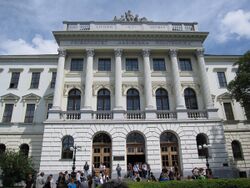Organization:Lviv Polytechnic
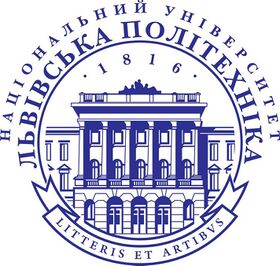 Lviv Polytechnic coat of arms | |
| Motto | Litteris et artibus (Latin) |
|---|---|
| Type | Public |
| Established | 1816 (as Technical Academy) |
| Chancellor | Yuriy Bobalo |
| Rector | Bobalo Yuriy Yaroslavovich |
| Students | 35,000 |
| Location | Lviv , Lviv Oblast , |
| Affiliations | European University Association, Association of Ukrainian Universities |
| Website | http://www.lp.edu.ua/ |
Lviv Polytechnic National University (Ukrainian: Національний університет "Львівська політехніка") is the largest scientific university in Lviv. Since its foundation in 1816, it has been one of the most important centres of science and technological development in Central Europe. In the interbellum period, the Polytechnic was one of the most important technical colleges in Poland, together with the Warsaw Polytechnic. Today the University is also the National Defense University (Military Institution).
History
The history of the Lviv Polytechnic National University begins during the Austrian Empire, and extends through the Second Polish Republic, the Nazi Occupation, the Soviet Union, and into independent Ukraine .
On March 7, 1816 , the Tsisar-Royal Real School was opened in Lemberg (Lviv). A technical school was established with the help of the newly introduced local industrial tax. In the curricula of the Royall School, the main focus was assigned to the subjects of the natural-mathematical cycle, drawing, drawing and the study of new modern languages. The royal-school educational process was based on German educational programs that were adapted to local requirements. The newly created Royal School was housed in a beautiful building at number 20 on the then-current Pekarskaya Street (now Armenian).
In 1825, according to the Royal Decree of the Austrian Emperor Franz I, the three-level Tsissar-Royal Real School was reorganised into the Tsissar-Royal School of Technical Sciences and Trade in Lviv.
In 1835, the School of Technical Sciences and Trade turned into the Tisar-Royal Real-Trade Academy in Lviv. Here in 1841 the technical faculty was opened.
In 1844, in the house of Darovskogo, on the present Armenian street, 2, the Tsisars-Royal Technical Academy was opened in Lviv with technical and trade departments (faculties). It was one of the first academic technical schools in Europe and the first in Ukraine. In 1877, at the start of a new academic year, under the leadership of the new rector Julian Zachariewicz, construction began of a new building to the academy (in the present Stepan Bandera street). Julian Zachariewicz was also an accomplished architect, and designed this building, based on the 1820s Technical University in Vienna, and the chemical laboratory.
At the same time, the academy was renamed Polytechnic School and included in the academic schools of the Austro-Hungarian Empire .
On 10 July 1912, Maria Sklodowska-Curie delivered a lecture at the Lviv Polytechnic School . On the same day, the Academic Council of Polytechnics honoured Mary with the title of Honorary Doctor of Technical Sciences. Her name was immortalised on the honorary board of doctors honoris causa of Lviv Polytechnic.
Since 1921 the institution has been called "Lviv Polytechnic", and since 1939 - Lviv Polytechnic Institute.
In June 1993 , one year before the celebration of its 150th anniversary, the Lviv Polytechnic Institute received the highest - the fourth - the level of accreditation, the status of the university and the name of the State University "Lviv Polytechnic" . In 2000 Polytechnic received the status of a national university .
On July 8, 2009 , the Cabinet of Ministers of Ukraine, at its meeting, granted the National University "Lviv Polytechnic" the status of a self-governing research national higher educational institution.[1]
Austrian Empire
In 1817, the Austrian Empire opened a secondary technical school in Lemberg,[2] divided into a technical school and a commercial school. However, the official change to a technical academy began in 1844, as noted in the following timeline:
- November 4, 1844: The school was upgraded to the Technical Academy Lemberg. Its first director was Austrian Florian Schindler, former director of the Technical College in Brünn (Brno). The building was situated at the corner of Virmenska and Teatralna streets in the building of Darovsky. The school had two departments – technical and commercial. Education lasted three years.
- November 1, 1848: During the Revolutions of 1848, the town's center was shelled by the Austrian artillery of General Wilhelm Hammerstein. The building of the technical academy was destroyed by fire. Lectures were held in the town municipality building (3rd floor) and continued there till 1850.
- December 4, 1850: Studies resume in the newly restored building.
- 1851: The number of students at the technical academy was 220, out of which 98 were Polish, 50 Jewish, 48 German, 19 Ukrainian/Ruthenian, 4 Czech and 2 Hungarian. In the same year, professor Wawrzyniec Zmurko (graduate of the Vienna Polytechnic) became director of the Department of Mathematics, as the first Pole in the history of the school. Zmurko is considered as founder of the Lwów School of Mathematics.
- 1852/1853: The beginning of the academy reorganization, which was suggested by Josef Weiser. He wanted the academy to be modelled after Paris Polytechnic, with two-level education.
- 1857–1868: Rudolf Günsberg was the assistant of chemistry and the assistant professor of technological chemistry.
- 1870: A Decree of Emperor Franz Joseph I of Austria established Polish as the official language of the school. Most professors who were not proficient in Polish left the Polytechnic.
- 1872: The Ministry of Affairs of Religions and Education gave permission to teach chemical technologies. Rudolf Günsberg started as the full professor of applied chemistry.
- March 12, 1872: Professor of physics Feliks Strzelecki was elected as the first rector.
- April 1, 1874 – October 1877: Academy obtained permission to build new academic premises. Julian Zachariewicz was elected as the construction superintendent. He ordered that the facade of the building be modelled after the building of the Munich Polytechnic.
- October 7, 1877: The first telephone conversation on the territory of the Austro-Hungarian Empire took place, followed by a lecture of Doctor Roman Gostkowski. The Telephone line connected the assembly hall of the main building with the premises of the Department of Technical Chemistry.
- November 15, 1877: Inauguration of the new rector – professor of architecture Julian Zachariewicz. On the same day, consecration of newly constructed school's building took place, carried out by three Lvov's archbishops - Roman Catholic, Greek-Catholic and Armenian-Catholic and witnessed by Governor of Galicia, Alfred Potocki.
- 1877: Technical academy was renamed to Polytechnical School (Technische Hochschule). However, the rector as well as other professors refrained from using a German-sounding name, and insisted on calling it in Polish Szkola Politechniczna.
- September 13, 1880: Emperor Franz Joseph I visited the polytechnical school. During that visit he ordered Jan Matejko to depict the technical progress of mankind in 11 pictures. Now these pictures decorate the assembly hall. The Emperor signed a guest book in Polish; the book is now kept in Wrocław.
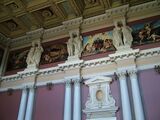
|
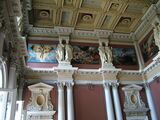
|
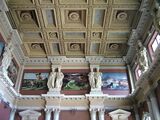
|
 Images of the Aula of the Polytechnic, with 11 paintings by Jan Matejko. |
- 1893: Due to efforts of Stanislaw Madejski, Minister of Education of Galicia, diplomas of the Polytechnic are regarded equal to diplomas of other renowned European schools of this kind.
- 1894: The 50th jubilee of the Polytechnical School. To commemorate that date, Professor Władysław Zajączkowski published the book "The Imperial Polytechnical School in Lviv. Historical essay on its foundation and development as well as its present state".
- February 13, 1894: The Polytechnic School Statute was adopted.
- 1905: Lviv Polytechnical School possessed the second place in the number of students after Vienna.
- 1914: As there were no limits on foreign students, in that year, students from the Russian part of Poland were some 30% of all. In that year, the school owned 11 laboratories and an astronomical station, and its library had some 20000 books.
- Russian occupation shut down the Polytechnic University for the 1914/15 academic year.
Second Polish Republic
- November 1918: Students and professors of the Polytechnic take part in the Polish-Ukrainian war over Eastern Galicia. Among those fighting on Polish side, there are Kazimierz Bartel, Stefan Bryła and Antoni Wereszczynski, who later became the rector.
- November 8, 1919: Polish Government unifies the Agricultural Academy in Dublany and Higher School of Forestry (Lwów) with Politechnical School.
- June 28, 1920: Adoption of the New Statute and renaming the Polytechnical School into Lwów Polytechnic (Polish: Politechnika Lwowska).
- November 19, 1922: The Polytechnic is awarded by the Polish Government with Cross of Defenders of Lwów. Earlier in that year, Marshal of France Ferdinand Foch comes to Lwów and is awarded the title of doctor honoris causa of the school.
- February 23, 1931: Council of the Faculty of Agriculture and Forestry of Polytechnic conferred academic rank of honorary doctor to professor Nils Handson (Stockholm, Sweden).
- 1934: Construction of the building of the library on Professor Street 1 was finished.
- November 11, 1936: President Ignacy Mościcki awards the school with Order Polonia Restituta in appreciation of its achievements.
Soviet Union
- October 1939: The polytechnic was renamed to Lviv Polytechnical Institute.
Nazi occupation
- July 4, 1941 (at night): On Vuletsky Hills Germany occupiers, shot professors of the Polytechnic Institute – Wlodzimierz Krukowski, Antoni Łomnicki, Stanislaw Pilat, Włodzimierz Stożek, Kazimierz Vetulani, Kasper Weigel, Roman Witkiewicz, Tadeusz Boy-Żeleński and others.
- July 26, 1941: Professor Kazimierz Bartel was murdered in the basements of Gestapo headquarters.
- Spring 1942 – Spring 1944: Special three-month courses for electrical engineers, road and bridge civil engineers, agrarian engineers, etc. were working in the premises, of the present Mechanical Technology Department. After the war, these classes were continued in Gliwice.
- Autumn 1944: The 100th jubilee of Lviv Polytechnical Institute was celebrated very quietly in Lviv – the Second World War was still going on.
Soviet Union
- 1945: The Geodetic Department was founded. Most professors of Polish ethnicity, leave Lviv for Poland. The Polish traditions developed at the Polytechnic were continued at the Silesian University of Technology in Gliwice and Wrocław University of Technology.
- October 1946: The Lviv Polytechnical Institute began to publish the periodical newspaper "Lviv Polytechnic".
- 1952: The Radio-engineering Department was founded.
- 1962: The Automation, Electromechanical and Mechanical Technology Departments were founded.
- 1966: The Economical Engineering Department was founded.
- 1967: The Department of Technology of Organic Substances was founded.
- 1970: The second building of the library was erected.
- 1971: The Heating Engineering Department was founded.
- 1989: Democratic changes began at Polytechnical Institute
- April 10, 1991: Inauguration of the first democratically elected rector for the last 50 years – Yu. Rudavsky.
Ukraine
- 1992: Computer Engineering Department and Information Technology Department were founded.
- 1992: Institute of Humanities was founded on the basis of the following chairs:
- History of Ukraine, its Science and Technology
- Ukrainian Language
- Politology
- Philosophy
- Foreign Languages (English, German, French, Spanish, Russian, Japanese)
- 1993: The Department of Applied Mathematics was founded.
- June 1993: The Lviv Polytechnical Institute got the status of university, becoming Lviv Polytechnic State University.
- 1994: Lviv Polytechnic got the status of national university becoming Lviv Polytechnic National University.
- July 8, 2009: The Lviv Polytechnic received the status of self-governing (autonomous) national research university.
Structure
The National University "Lviv Polytechnic" includes:
- 16 educational institutes (as well as the Institute of distance learning and the International Institute of Education, Culture and Relations with the Diaspora );
- Research Centre
- Scientific and technical library ;
- 8 colleges, two gymnasiums;
- 34 teaching and laboratory buildings;
- 12 dormitories ;
- 3 sports and health camps for students and teachers;
- Publishing house of Lviv Polytechnic National University ;
- People's House "Prosvita (Lviv Polytechnic)" ;
- Design and Construction Association "Polytechnic";
- a geodetic polygon and an astronomical-geodesic laboratory.
The university has more than 35,000 students and extramural students. The training of specialists is carried out in 64 bachelor's areas and 124 specialities, of which 123 are master's level.
The teaching process is provided by a teaching staff of more than 2,200 people, of whom more than 320 are doctors of sciences and more than 1200 are associate professors, PhD. The educational process involves scientists from scientific institutions of the National Academy of Sciences of Ukraine, production enterprises and design institutes.
Notable alumni
- Tatiana Anodina (Soviet aviation engineer, long-term chief of the Interstate Aviation Committee in Russia )
- Józef Adam Baczewski (alcohol entrepreneur and owner of J. A. Baczewski company)
- Stefan Banach (mathematician)
- Kazimierz Bartel (Prime minister of Poland)
- Stefan Bryła (Polish construction engineer and welding pioneer)
- Emil Czyrniański (Polish chemist)
- Tsakhiagiin Elbegdorj (President of Mongolia)
- Vera Kamsha (Russian fantasy writer)
- Polina Katsen (Ukrainian Women's National Chess Champion)
- Yuriy Lutsenko (Ukrainian politician and Prosecutor General of Ukraine)
- Apollinaire Osadca (New York architect, class of 1942)
- Włodzimierz Puchalski (photographer and film director)
- Wilhelm Orlik-Rueckemann (Polish general)
- Jan Jagmin-Sadowski (Polish general)
- Roman Shukhevych (Ukrainian politician and military leader)
- Klemens Stefan Sielecki (Polish engineer and technical director of Fablok)
- Władysław Sikorski (Polish general and prime minister)
- Stanislaw Ulam (mathematician, member of the Manhattan Project, major contributor to hydrogen bomb construction)
- Piotr Wilniewczyc (engineer)
Notable professors
- Kazimierz Bartel
- Stefan Bryła
- Włodzimierz Stożek
- Kazimierz Kuratowski
- Antoni Łomnicki
- Jan Henryk de Rosen
- Otto Nadolski
- Tytus Maksymilian Huber
- Stefan Banach
Other
- Ignacy Mościcki
References
External links
[ ⚑ ] 49°50′08″N 24°00′53″E / 49.83556°N 24.01472°E
